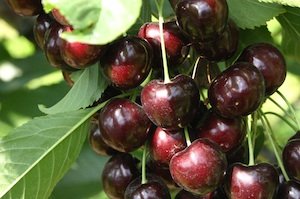
Degree-day accumulations in Washington’s growing districts are running ahead of the past few years.
Courtesy WSU
Northwest cherry growers have a great opportunity for success this season with a fresh crop estimated at 18 million 20-pound boxes, B.J. Thurlby said during the Five-State Cherry Meeting in Richland, Washington, yesterday (May 16). That’s almost 5 million boxes fewer than last year’s record crop.
The season is likely to get off to an early start with the first cherries shipped out around June 4, three days earlier than last year. However, because the California season is also early, there should be minimum overlap in the marketplace, said Thurlby, who heads Northwest Cherry Growers, the promotion entity for cherries produced in Washington, Oregon, Utah, Montana, and Idaho. Last year, the end of the California season and the start of the Northwest’s overlapped by 22 days.
“This is certainly a crop with great potential,” Thurlby said, though he avoided calling it a slam dunk. “We’re looking at having a very solid year for the growers. I think there are more opportunities than challenges right now, but a lot of it comes down to—like every year—what Mother Nature sends us in the next few months.”
California
West Mathison, president of Stemilt Growers, Inc., Wenatchee, which grows and packs cherries in both California and Washington, said his California packing plant hit peak production on May 12, which was unusually early, and would continue in peak production in the next seven days. The season should be wrapping up by June 3 to 5. Fruit size and firmness has been good, and there should be nice cherries going to market as long as it doesn’t rain, he added.
The last of the Bing cherries are from orchards that an extremely poor set, so that fruit should not be a factor for the Northwest. Mathison expected that the market would be undersupplied with cherries until July.
Early season
Thurlby reported that degree-day accumulation in most Northwest growing districts was running ahead of the past several years. There was a spread in bloom between the districts, suggesting that harvest will also be extended. However, the Washington crop was affected by poor pollinating conditions, and orchards in the Tri-Cities area had cold damage during bloom.
Yakima grower Mark Roy said there’s great variation between orchards in the Yakima district, which includes the Tri-Cities and parts of the Columbia Basin. Some growers are reporting crops of 2 tons per acre while others expect 8 tons. Overall, the district is forecasting a fresh crop of 60,000 tons, down from almost 81,500 tons last season.
The Wenatchee district is also seeing fewer cherries and is forecasting 81,500 tons, down from over 100,000 last year, putting the total estimate for the state at 141,500, down from 182,700 tons in 2012.
Oregon
Oregon districts should be closer to last year’s figures. Hood River is forecasting 6,200 tons, down 500 tons from 2012, and The Dalles should pick 29,000 tons, down about 200 tons from last year. The total for Oregon, including Milton-Freewater and the Willamette Valley, is 36,500 tons, compared with 39,229 a year ago.
Total Northwest production, including Utah (750 tons), Montana (1,700 tons) and Idaho (1,600 tons) is forecast at 182,050 tons, the equivalent of 18.2 million boxes, which would make it the second-largest crop ever.
Earlier in the year, Northwest Cherry Growers set its budget based on a potential crop of 20 million boxes. Thurlby proposed to maintain that budget and dip into reserves if necessary, as its reserves had been building up. Northwest Cherry Growers staff have been working with retailers since February to set up promotions.
“Every promotion will be critical,” he said. “I recommend we stay our course. I don’t think you can promote too much or create too much demand.”

Leave A Comment